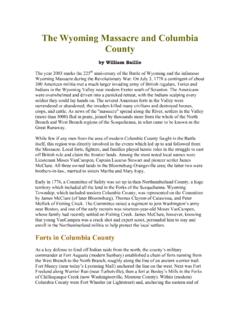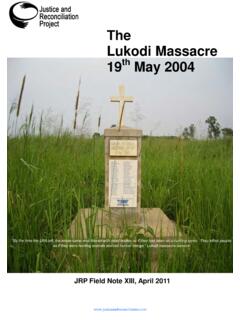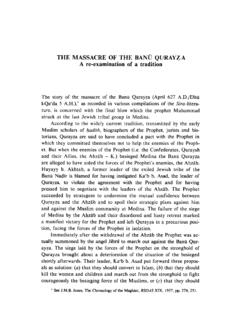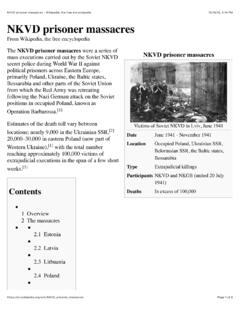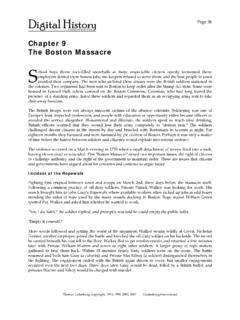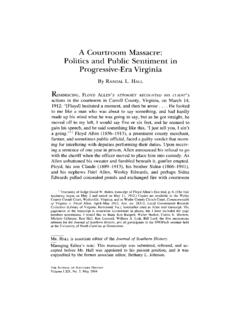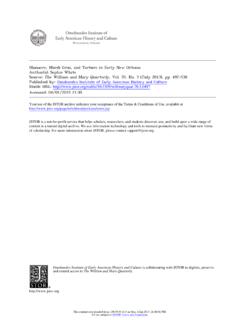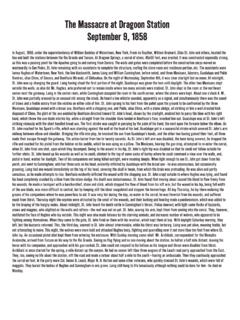Transcription of The Whitmoyer Saga - Bloomsburg, Pennsylvania
1 The Whitmoyer Saga W. M. Baillie The Whitmoyers on the Frontier The story of the " Whitmoyer massacre " on Easter Sunday morning 1780 and the subsequent Indian captivity of five of the children is one of the most dramatic and moving stories from the Pennsylvania frontier. The histories of Columbia County include several stories from the Revolutionary War era about local Indian raids and the carrying away of captives. Among these stories none is more remarkable, for both horror and adventure, than that of the Whitmoyers. The " massacre " itself was brief and stark, but the intriguing tale continues for years after 1780 in the later history of the surviving Whitmoyer children.
2 Scattered in various locations and raised for some years in Indian villages, the five children experienced frontier life in the most down-to-earth ways. Through the chances of wartime some ended up on each side of the new border between the United States and Canada, and their families later fought on opposite sides in the War of 1812. Three of them left behind stories of their ordeals, tales which found their way into print and rank among the prime "captivity narratives" in American historical literature. When the area in the Forks of the Susquehanna was opened to settlement in 1769, one of the pioneer settlers was George Whitmoyer , of Lancaster County.
3 He was probably descended from Peter Witmer, one of three brothers from the Swiss canton of Zurich who came to Philadelphia in 1733. In about 1772 George brought his family to the headwaters of Chillisquaque Creek in what is now Madison Township. They settled in the valley along Mud Creek in modern Jerseytown, built a cabin and made a life in the wilderness. By 1780 Peter and his wife (n e Sheets) had nine children: Sarah (Sally) 17, Philip (the oldest son, probably 15), Catharine 14, Ann 12, Mary 11, Peter 8, George 6, John 4, and an infant. Only a few other families were neighbors: the Eves near Millville, the Bilhimes and Wellivers nearer to the Whitmoyers.
4 Native Americans hunted in the region and passed nearby on the Nescopeck trail from the West Branch at Muncy to the North Branch at Nescopeck. When word reached these settlers of the July 4, 1778 Wyoming massacre (near modern Wilkes-Barre), the Eves, Welliver and Bilhime families all fled from their homes to safety at downriver forts. The Whitmoyers, however, resolved to stay put a decision which proved to be a disastrous mistake. The Easter Morning massacre Early on Easter morning in 1780, the family were still in bed except the two girls Catharine and Ann, who had started out before daybreak to gather syrup at the Sugar Bush [grove of maples toward Millville].
5 Oldest son Philip had just arisen and was at the cabin hearth trying to start a fire. Suddenly the door burst open, a terrifying yell sounded, and several Indians crowded in. The father, awaking and immediately realizing the danger, reached for his rifle, but a shot from the doorway killed him instantly. Before Philip could rise from the hearth, a tomahawk cleaved his skull, and in a moment another killed his mother as she reached for her infant. All three of the slain were scalped and the cabin was ransacked. The six remaining children were hustled outside, Sarah cradling the baby who had fallen from her mother s arms.
6 The children were set onto various Indians horses, Sarah holding the infant. By this time the cabin was afire, and the Indians, fearing that the rising smoke would alert the American rangers in the area, made ready quickly to ride off with the children, leaving the dead and the burning cabin behind. When the baby began to wail, the Indian riding behind Sally suddenly snatched it from her arms and bashed its head against a tree. Sally and Mary both screamed and struggled to get down and run to the baby, but Sally s captor struck her and stuck a knife in Mary s side, bringing a rush of blood to her nightgown.
7 Such was the scene shortly after when the two remaining children, Catharine and Ann, alerted by the screams or the rising smoke, returned from the Sugar Bush to find their dead parents and siblings and their home ablaze. The spring close by was red and gory where the raiders had washed off the scalps they collected. By one account, the two girls set off to walk the eighteen miles to Northumberland, the nearest settlement with a detachment of soldiers. (A different account has the girls hiding terrified at the Sugar Bush until found by soldiers three days later.) The next day, in any case, a small body of soldiers came from Northumberland and found the dead bodies partially burned, all the buildings destroyed, the cattle slaughtered, everything of value plundered.
8 The militia commander decided that he could not spare scouts and cavalry to pursue the Indians, so the captive children were given up for lost. The soldiers buried the dead and returned sorrowfully to their fort. [The foundation of the home was reportedly still visible near Jerseytown as late as 1883, when Jerseytown resident Samuel Brugler related the massacre story he had heard as a boy.] The Indians, meanwhile, with their horrified child captives traveled hard westward and then north, moving two days without stopping to gather food. The raiders were from three different groups of Native Americans: Oneidas, Mohawks and Delawares; all three groups favored the British side in the white men s war because they feared rightly, as it turned out that the Americans if victorious would settle on their hunting lands.
9 On the second night the party split up: Mohawks took Sarah, Oneidas took Peter and George, and Delawares kept Mary and John. Peter and George were apparently "redeemed" shortly afterward and went to live with their mother s family in upstate New York. The three other captives, however, had longer stays with their captors. Sarah and the Seneca Chief Seventeen-year-old Sarah (called Sally) was taken to a Mohawk village in the Genesee country known as Little Beard s Town (on the Genesee River near upstate Wellsville, New York). There she was adopted by a Mohawk family, with whom she wandered often up and down the Genesee valley.
10 While life was full of hardships, she was treated with kindliness by her new family. As a handsome young woman, she was designated by the Mohawk council for marriage into one of their clans; she drew the particular attention of one young chief, who asked her family for her hand. Sally put him off, but she knew that she could not delay a decision indefinitely; she heard that the war was soon to end, and she hoped desperately that she might be freed in a general release of captives. About this time word came of a "pigeon roost" in the lower Genesee valley; passenger pigeons, then plentiful, were nesting by the millions in a certain forest area.

